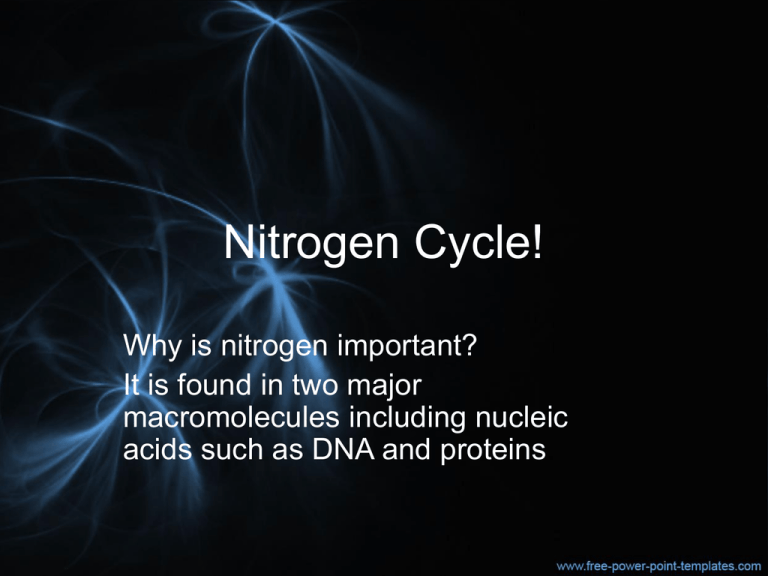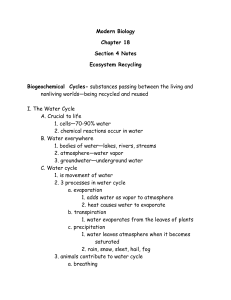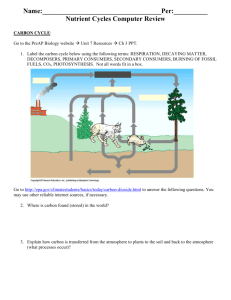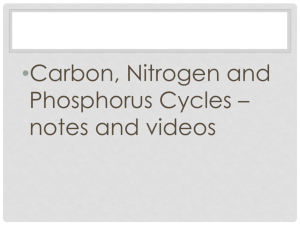Cycles presentation
advertisement

Nitrogen Cycle! Why is nitrogen important? It is found in two major macromolecules including nucleic acids such as DNA and proteins. Nitrogen is found in two major macromolecules – you can’t live with out it! Protein DNA Most of the gas in the atmosphere is nitrogen, but it is unusable by plants and animals. Only certain bacteria and algae are able to fix nitrogen into a usable form. Plants absorb Nitrogen through their roots and assimilate it into nucleic acids and proteins. Animals get their nitrogen from the food they eat. Decomposers! Most of the nitrogen in the cycle is found in living organisms and is recycled by the bacteria and fungal decomposers. These bacteria and fungi break down waste products and dead organisms into a form usable to plants. Some animals like earthworms and roundworms eat decaying material in soil. Some bacteria take usable nitrogen and return it to the soil or atmosphere Eutrophication • Excess nitrogen may be added to an aquatic ecosystem and cause the algae to grow in excess which is called an algal bloom. • Water becomes cloudy – turbid, blocks sunlight which will decrease photosynthesis. • Algae die and decompose and oxygen is depleted by cellular respiration. • Hypo Elements in Ecosystems • Remember SPONCH? • 95% of most organisms are made up of various chemical compounds composed of just four different elements: oxygen, carbon, hydrogen, and nitrogen. • Sulfur in proteins and phosphorus in nucleic acids are also very important though. Cycles of Matter in Ecosystems • Biogeochemical cycles refer to the pathways through which a chemical moves through the biosphere. • The primary biogeochemical cycles studied in ecology are: • • • • Water Cycle Carbon Cycle Nitrogen Cycle Phosphorous Cycle The water cycle Over 70% of the Earth’s surface is covered by water. The vast majority of this is stored in the oceans and seas of the world. Water is neither created nor destroyed. It is cycled around over and over again in the Earth’s atmosphere. This recycling of water is called the water cycle. The water cycle The water cycle Movement of Water 1.Water vapor molecules enter the atmosphere through evaporation and transpiration (plants) 2.The water vapor condenses in clouds when it cools. 3.The water returns to the oceans, lands, and lakes by precipitation. 4.Water that enters the soil returns to the oceans through runoff. What is transpiration? A. The precipitation of water from clouds. B. The movement of water from the ocean to the atmosphere. C. The movement of water through plants to the atmosphere. D. The movement of water from the ground to the ocean. How does water that enters the soil eventually return to the ocean? A. B. C. D. Precipitation Condensation Runoff Transpiration • As well as the water cycle, three others are important to understand: – Carbon – Nitrogen – Phosphorous • These are elements that are important nutrients. • Primary producers like plants typically obtain nutrients from their environment. • Consumers obtain nutrients by eating other organisms. Why is carbon important? Proteins, fats and sugar all contain carbon. Life without carbon would be very different and might be impossible. Carbon is present in the atmosphere as carbon dioxide. Plants use carbon dioxide during photosynthesis to produce sugars. The carbon is then transferred to animals along food chains. What happens to the carbon in organisms when they die? As dead matter decomposes, carbon is released back into the atmosphere in the form of carbon dioxide. The carbon from dead organisms can also form fossil fuels and sedimentary rocks such as limestone. These are long-term carbon stores. Are carbon dioxide levels rising? Although the total amount of carbon in the environment is CO2 conc. (ppm) fixed, carbon dioxide levels are constantly fluctuating. 400 300 200 100 0 1960 1980 2000 Currently, the general trend shows an increasing level of carbon dioxide. Why might this be happening? year Many scientists believe that human activities, such as burning fossil fuels and making cement from limestone, are responsible for increasing carbon dioxide levels. What environmental problems might this cause? The Oceans 1. The overwhelming majority of carbon on the planet is contained in the oceans and in the rock under the oceans. 2. It comes from atmospheric CO2, living and dead marine life and inorganic carbon containing minerals. How does carbon enter the biosphere? A. B. C. D. Through oceans Through heterotrophs Through detrivores Through autotrophs How can carbon enter the atmosphere? A. B. C. D. By cellular respiration By photosynthesis By decomposition of living things A and C Where does most of the carbon on earth exist? A. B. C. D. Fossil fuels Oceans Living biomass Atmosphere Why is nitrogen so important? Nitrogen is essential for growth because it is used by plants and animals to make proteins. Nitrogen makes up about 78% of the atmosphere. However, nitrogen deficiency is the most common cause of poor plant growth. Why are plants unable to use the nitrogen straight from the air? Nitrogen gas (N2) is unreactive and is not easily converted into other compounds. Most plants can only take up nitrogen in the form of ammonia or nitrate. How is atmospheric nitrogen changed into a useable form? How are nitrates produced? Nitrates are important because they are a form of nitrogen that plants can absorb. Nitrogen is used to make protein, and is passed from plants to animals along food chains. What processes add nitrates to the soil? Decomposers release ammonium compounds from waste (such as urine) and dead matter. Nitrifying bacteria then convert the ammonium compounds into nitrates. Some nitrogen compounds form during lightning strikes and are washed into the soil by rain water. Lightning provides the high level of energy required for nitrogen to react and form compounds. Can plants add nitrogen to the soil? This rugged place is in Iceland. Deforestation by the original settlers and high levels of volcanic activity have left much of the country as bare lava or sand; an environment in which few plants grow. In the 1960s, the country began to manage its soil, and dropped millions of lupin seeds from the air. Why might lupins survive where nothing else grows? What are legumes? Most plants need nitrates from the soil because the nitrogen in air is too unreactive. These plants rely on the presence of nitrifying bacteria in the soil or artificial fertilizers. By contrast, lupins and other legumes, such as clover and peas, are selfsufficient. Nitrogen-fixing bacteria living in the root nodules of legumes convert nitrogen gas into nitrates, improving the fertility of poor-quality soils. How can nitrates be added to soil? Nitrates are vital for plant growth, but levels in the soil are gradually depleted as crops grow. What methods can farmers use to increase soil nitrate levels? Modern, intensive farming uses artificial fertilizers. These are made by the Haber process. However, run-off into nearby rivers and lakes can cause eutrophication. Organic farming uses manure – a natural fertilizer. Crop rotation, a system that varies the crops planted each season, is also used to maintain soil fertility. Keeping soil fertile The Nitrogen Cycle The Phosphorous Cycle Phosphorus Phosphorous is an essential nutrient because it is a building block for RNA, DNA, and ATP. Unlike carbon and nitrogen, phosphorous is not abundant in the atmosphere and is mostly found on land in rocks, soil, and ocean sediment. Storage of Phosphorus • Most phosphorous is stored in the form of inorganic phosphate within rocks and sediment until they eventually wear down and release the phosphate. • Phosphate molecules may be washed into rivers, streams, and eventually the ocean where they are used by marine organisms. • Phosphate may remain in soil on land and be absorbed into plants that convert them into organic compounds to be useful to living organisms. Nutrient Limitations in Ecosystems • Which nutrient is most essential for living things? • All of the nutrients discussed are necessary to maintain a healthy, productive ecosystem. • When an ecosystem's productivity is slowed by one nutrient that is in limited supply or cycles very slowly that substance is referred to as the limiting nutrient. Water pollution Sewage, industrial waste, oil, pesticides and fertilizers all pollute water. Fertilizers and sewage can easily be washed into rivers, streams and lakes. The nutrients, phosphates and nitrates in these substances cause eutrophication. Eutrophication is the accumulation of nutrients in water, which causes excessive algal growth. This leads to a reduction in oxygen levels and the death of aquatic life.









